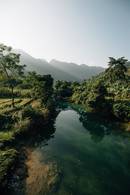News

This article originally appeared on the UN-REDD Programme website. Click here to go to the original post.
Nine years since the launch of the UN-REDD Viet Nam Phase I Programme, Vietnam has marked a milestone at the end of 2018, by closing its Phase II Programme. What have these nine years achieved, and what has it meant for REDD+ in general and Vietnam in particular?
“Graduation from the REDD+ readiness phase” is the short answer, but for Vietnam, it is more than that. REDD+ readiness has paved the way for transformational change in the forestry and land use sectors. Back in 2009, when REDD+ was...
Mekong, Mumbai, and Beyond: Regionally-Developed Tool Expands to Support Global Forest Monitoring
18/03/2019
18/03/2019

This article originally appeared on the UN-REDD Programme website. Click here to go to the original post.
“Land cover mapping in the lower Mekong has been challenging in the past, based primarily on outdated maps using different criteria,” said Dr. David Saah, Professor at the University of San Francisco and Managing Principal of the Spatial Informatics Group (SIG). Competing objectives, priorities and resource limitations, in the Mekong and beyond, often mean differential treatment and sometimes omission of key land cover features. For example, forest ministries focus on mapping forest biodiversity, structure, condition, and use. Agriculture departments typically mask out forest cover, displaying features...
Brazil presents preliminary results from the National Forest Inventory carried out in Caçador
15/03/2019
15/03/2019

On March 14, the Director of Research and Information, Joberto Freitas, presented preliminary data from the National Forest Inventory (NFI) at an event held in the municipality of Caçador, Santa Catarina. The meeting gathered representatives of the Municipal Secretariat for Agriculture, Rural Development and Environment, City Hall, as well as representatives of forestry production sector and academia. Caçador is the first municipality in the country to participate in the survey conducted by the Brazilian Forest Service. The initiative was a pilot project to adapt the NFI methodology on the municipal scale. The existence of the Caçador Forests Model (Bosque Modelo de Caçador)...

The Argentine Republic has a native forest cover of 53.6 million hectares (ha), distributed in seven regions that range from temperate forests to subtropical forests. The loss of coverage of native forests has had a great impact on the country's forestry sector. However, deforestation continues to be relevant, despite its slowdown in recent years. Between 2006 and 2008, the annual rate of deforestation decreased from more than 360 000 hectares per year to less than 200 000 hectares per year as of 2015. The main drivers of deforestation are linked to the growth of the agricultural frontier, urbanization, of forest...

For Russia, the issue of science-based restoration and sustainable, wet management of peatlands is particularly relevant. The urgency is determined by the fact that this type of wetlands perform a number of important ecosystem functions for humans. If there is a functional failure, caused in particular by anthropogenic factors, the negative consequences are numerous and diverse.
Organized by FAO, a round table discussion entitled “Climate-smart agriculture in wetlands and peatlands: Prospect for Russia” was held on 5 March on the premises of the Russian State Agrarian University – Timiryazev Academy. Experts were looking into specific opportunities to further develop wet biomass...

